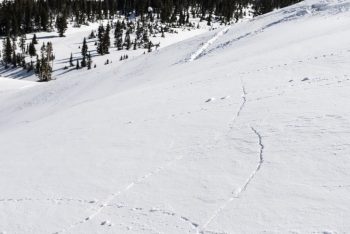Thanksgiving and avalanches. By Zach Guy

Shooting cracks are a sign that the snowpack might have taken a few too many scoops of mashed potatoes and stuffing.
It has been a wonderfully warm and dry fall, which is hard to complain about. But if we can be brutally honest with the weather gods, fall really was starting to wear out its welcome, and we are happy to open the door to winter. There’s nothing quite like surfing over powder, so it’s time to dust off those skis, find your beacon, shovel, and probe, and start tuning into our daily avalanche reports.
Early season skiing and riding comes with some challenges and risks. The snow coverage is still quite shallow, so striking rocks and logs are tough to avoid and they can end your season pretty quickly. My strategies include getting on the fattest skis I can find, riding like a gaper in the backseat, and using releasable bindings in case my tips dive under a log or rock. I’ve seen a few too many broken tib-fibs from early season riding. And of course, we all want to go to where the snowpack is deepest, which can open the doors to another scary threat: avalanches. This time of year, the slopes holding deep and continuous coverage often carry the greatest risk of triggering an avalanche. It is almost impossible to go through fall without a shallow, crusty, and faceting foundation forming on the ground. Then once we start building a deeper snowpack, it creates a persistent slab avalanche problem above these layers.

Skier triggered slides in Red Lady Bowl
I like analogies, so let’s compare our current year’s snowpack to your most recent Thanksgiving celebration. You probably avoided food all day, maybe even went for a turkey trot to work up an appetite in preparation for the big feast. A significant drought, indeed. That left you weak and frail, just like the lingering snowpack layers that survived our fall drought. Then once dinner time (i.e. winter time) rolled around, you started off at a decent pace. Snacked on some hor devoirs, some salad, maybe some of your Uncle’s famous deviled eggs or your Grandma’s bean dip. Our first few storms behaved in similar fashion, fairly small and steady loads, with a handful of isolated avalanches. Nothing too scary yet. Then it is dinner time: you go for the mash potatoes, stuffing, turkey, green bean casserole, and of course drown it all under gravy. Extra rolls? Why not? Whammo. That’s a heavy load, just like our last storm, which dumped almost 2 feet in places. Both scenarios are dangerous. You could collapse on the couch just as easily as you could collapse those fragile weak layers near the ground. During and after the storm, we saw both natural and skier triggered avalanches, some quite large and surprisingly wide. As of Tuesday night, I’m expecting we’ll see evidence of a lot more avalanche activity as we get better visibility over the next few days. So tread carefully out there, and check the avalanche report before you go out. So what’s next for our snowpack? Does it reach for another plateful of mashed potatoes before slamming down some pumpkin pie and faceplanting onto the floor? Or does it slowly nibble at the leftover turkey and try to stay awake for family charades? Only the weather can dictate that one. But you can be the captain of your risks by making rational decisions and practicing your rescue skills. Is it a coincidence that this Friday night is our Annual Avalanche Awareness Night, with the theme “Human Factors and Decision Making”? Or that Saturday is our annual Beacon Brushup, a free and valuable opportunity to dial in your rescue skills for the winter? I think not. See you there!






